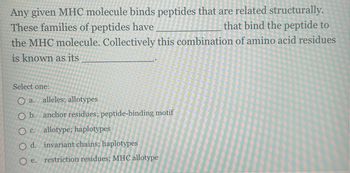
Human Anatomy & Physiology (11th Edition)
11th Edition
ISBN: 9780134580999
Author: Elaine N. Marieb, Katja N. Hoehn
Publisher: PEARSON
expand_more
expand_more
format_list_bulleted
Concept explainers
Question

Transcribed Image Text:Any given MHC molecule binds peptides that are related structurally.
These families of peptides have
that bind the peptide to
the MHC molecule. Collectively this combination of amino acid residues
is known as its
Select one:
O a. alleles; allotypes
O b. anchor residues; peptide-binding motif
O c. allotype; haplotypes
O d.
O e.
invariant chains; haplotypes
restriction residues; MHC allotype
Expert Solution
This question has been solved!
Explore an expertly crafted, step-by-step solution for a thorough understanding of key concepts.
Step by stepSolved in 3 steps

Knowledge Booster
Learn more about
Need a deep-dive on the concept behind this application? Look no further. Learn more about this topic, biology and related others by exploring similar questions and additional content below.Similar questions
- Identify which of the following statements regarding peptide–MHC molecule interactions are correct. (Select all that apply.) a. Peptides with different amino acid sequences may be able to bind to the same type of MHC molecule. b. Covalent bonds hold the peptide in the groove of the MHC molecule. c. The length of peptides bound by MHC class I molecules is shorter than that of those bound by MHC class II molecules. d. The groove of the MHC molecule is deep enough to accommodate two or more peptides. e. Binding pockets of MHC molecules anchor the side chains of only certain amino acids of the peptide. f. The amino- and carboxy-terminal amino acids of peptides are used for binding to MHC class I molecules, whereas amino acids along the length of the peptide are used for binding to MHC class II molecules. g. Only non-self peptides form stable interactions with MHC molecules. h. The type of MHC molecule presenting a non-self protein is informative regarding whether the…arrow_forwardDespite the important concerns about fatalities when infected, most people who become sick with COVID-19 have. Mild illness Severe illness Critical illnessarrow_forwardList the steps of MHC class II peptide formation and assembly.arrow_forward
- Describe serine-threonine membrane receptor.arrow_forwardAlpha Beta chain chain CHO CHO Disulfide bridge CHO CHO What kind of receptor is show in the figure? T-cell receptor impossible to tell B-cell receptor Variable region "V" Constant region "C" Hinge "H Transmembrane region Cytoplasmic tailarrow_forwardWhat polypeptide chains make up the MHC class molecule? MHC class II?arrow_forward
- A strain of mice has been identified that does not respond to LPS. This lack of response is due to a single amino acid change in the intracellular domain of mouse TLR4. Propose an explanation for the lack of responsearrow_forwardWith the disruption of PDHC activity, TCA cycle is also effected. which of the following intermediates have a high probability of being produced from other pathways/processes in a cell during sepsis? Group of answer choices Malate Acetyl-CoA Succinate Ketone bodies Fumerate Citrate Succinly-CoAarrow_forwardPolymorphism implies that each different MHCprotein binds a different peptide motif. For the MHCclass I polymorphisms, how many different MHCproteins are expressed in an individual? How many bythe entire human population?arrow_forward
- The S (spike) glycoprotein of coronaviruses can engage receptors by the N-terminal domain, the C-terminal domain, or both. The C-terminal domains of both human SARS coronaviruses bind ACE2 (angiotensin-converting enzyme 2), whereas that of MERS-CoV binds DDP4 (dipeptidyl peptidase 4). In contrast, in mouse hepatitis coronavirus (MHV) the N-terminal domain of S binds CEACAM (cell adhesion molecule 1). You have identified a novel coronavirus with an S protein that displays similarity to MHV at the N terminus and to SARS at the C terminus. What are the molecules most likely to function as receptors and how will you test this?arrow_forwardphagocytic cells recognize pathogen-associated molecular patterns using their: Group of answer choices phagosomes perforins pyrogens pattern-recognition receptorsarrow_forwardWritten answer with explanation onlyarrow_forward
arrow_back_ios
SEE MORE QUESTIONS
arrow_forward_ios
Recommended textbooks for you
 Human Anatomy & Physiology (11th Edition)BiologyISBN:9780134580999Author:Elaine N. Marieb, Katja N. HoehnPublisher:PEARSON
Human Anatomy & Physiology (11th Edition)BiologyISBN:9780134580999Author:Elaine N. Marieb, Katja N. HoehnPublisher:PEARSON Biology 2eBiologyISBN:9781947172517Author:Matthew Douglas, Jung Choi, Mary Ann ClarkPublisher:OpenStax
Biology 2eBiologyISBN:9781947172517Author:Matthew Douglas, Jung Choi, Mary Ann ClarkPublisher:OpenStax Anatomy & PhysiologyBiologyISBN:9781259398629Author:McKinley, Michael P., O'loughlin, Valerie Dean, Bidle, Theresa StouterPublisher:Mcgraw Hill Education,
Anatomy & PhysiologyBiologyISBN:9781259398629Author:McKinley, Michael P., O'loughlin, Valerie Dean, Bidle, Theresa StouterPublisher:Mcgraw Hill Education, Molecular Biology of the Cell (Sixth Edition)BiologyISBN:9780815344322Author:Bruce Alberts, Alexander D. Johnson, Julian Lewis, David Morgan, Martin Raff, Keith Roberts, Peter WalterPublisher:W. W. Norton & Company
Molecular Biology of the Cell (Sixth Edition)BiologyISBN:9780815344322Author:Bruce Alberts, Alexander D. Johnson, Julian Lewis, David Morgan, Martin Raff, Keith Roberts, Peter WalterPublisher:W. W. Norton & Company Laboratory Manual For Human Anatomy & PhysiologyBiologyISBN:9781260159363Author:Martin, Terry R., Prentice-craver, CynthiaPublisher:McGraw-Hill Publishing Co.
Laboratory Manual For Human Anatomy & PhysiologyBiologyISBN:9781260159363Author:Martin, Terry R., Prentice-craver, CynthiaPublisher:McGraw-Hill Publishing Co. Inquiry Into Life (16th Edition)BiologyISBN:9781260231700Author:Sylvia S. Mader, Michael WindelspechtPublisher:McGraw Hill Education
Inquiry Into Life (16th Edition)BiologyISBN:9781260231700Author:Sylvia S. Mader, Michael WindelspechtPublisher:McGraw Hill Education

Human Anatomy & Physiology (11th Edition)
Biology
ISBN:9780134580999
Author:Elaine N. Marieb, Katja N. Hoehn
Publisher:PEARSON

Biology 2e
Biology
ISBN:9781947172517
Author:Matthew Douglas, Jung Choi, Mary Ann Clark
Publisher:OpenStax

Anatomy & Physiology
Biology
ISBN:9781259398629
Author:McKinley, Michael P., O'loughlin, Valerie Dean, Bidle, Theresa Stouter
Publisher:Mcgraw Hill Education,

Molecular Biology of the Cell (Sixth Edition)
Biology
ISBN:9780815344322
Author:Bruce Alberts, Alexander D. Johnson, Julian Lewis, David Morgan, Martin Raff, Keith Roberts, Peter Walter
Publisher:W. W. Norton & Company

Laboratory Manual For Human Anatomy & Physiology
Biology
ISBN:9781260159363
Author:Martin, Terry R., Prentice-craver, Cynthia
Publisher:McGraw-Hill Publishing Co.

Inquiry Into Life (16th Edition)
Biology
ISBN:9781260231700
Author:Sylvia S. Mader, Michael Windelspecht
Publisher:McGraw Hill Education